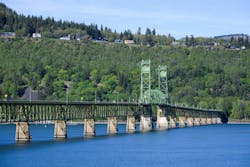FHWA Issues Record of Decision for Hood River–White Salmon Bridge Replacement
Key Takeaways
- FHWA’s Record of Decision clears the Hood River–White Salmon Bridge project to begin final design and federal funding pursuit.
- The century-old steel truss structure will be replaced with a modern, seismically resilient bridge featuring wider lanes and a separated bike/pedestrian path.
- Design improvements include a fixed span, enhanced marine navigation clearance, and advanced stormwater treatment systems.
Federal Highway Administration officials have formally approved the replacement of the 100-year-old Hood River-White Salmon Interstate Bridge in Hood River, Ore.
The long-awaited Record of Decision (ROD) concludes the National Environmental Policy Act (NEPA) review, documenting the selected alternative, and affirming that all environmental impacts, mitigation commitments, and public and tribal input have been fully evaluated, according to the project’s website.
With the ROD issued, the project can now move into final design, begin securing federal funding and obtain necessary permits, the project website states.
New Span Will Modernize Safety and Improve River Navigation
The existing steel truss bridge, which spans the Columbia River Gorge, will be replaced with a structure meeting current seismic and safety standards. The new crossing will include wider travel lanes, a separated bike and pedestrian path, a fixed span and improved marine navigation clearance, according to the project website. It will also incorporate a state-of-the-art stormwater management system to better protect the riverway, KOIN reported.
The $1.12 billion replacement will be financed with a mix of federal, state and local funds. Once full funding is secured, construction is expected to take four years, with the new bridge slated to open in 2031, KOIN reported. State officials emphasized that the new crossing will serve as a critical lifeline for the region during natural disasters.
Sources: Hood River-White Salmon Bridge Replacement, KOIN
